Tom's Hardware Verdict
Aside from a light gamma, the VI-01 offers solid performance for the money. Excellent video processing delivers quick response and low input lag which will satisfy gamers of all skill levels.
Pros
- +
Quick response with low input lag
- +
G-Sync certification
- +
Color accurate with calibration
- +
Excellent value
Cons
- -
Low gamma that can’t be adjusted
- -
No extra contrast in HDR mode
- -
No sRGB mode
Why you can trust Tom's Hardware
One of the great things about a popular gaming monitor category is that it spawns value models from less-visible manufacturers. Not only do these displays sell for low prices, but they also often come with excellent performance and solid build quality.
I rarely add a new company to my list of monitor reviews, but here, I have the Galax Vivance VI-01. It’s a 27-inch flat IPS panel with QHD resolution, 165 Hz, G-Sync certification, FreeSync compatibility, HDR and extended color. It checks all the important boxes for less than $300.
Galax Vivance VI-01 Specs
| Panel Type / Backlight | IPS / W-LED, edge array |
| Screen Size / Aspect Ratio | 27 inches / 16:9 |
| Max Resolution and Refresh Rate | 2560x1440 @ 165 Hz |
| Row 3 - Cell 0 | G-Sync 48-165 Hz |
| Row 4 - Cell 0 | FreeSync compatible |
| Native Color Depth and Gamut | 10-bit / DCI-P3 |
| Response Time (MPRT) | 1ms |
| Brightness (mfr) | 350 nits |
| Contrast (mfr) | 1,000:1 |
| 1,000:1 | 2x 2w |
| Video Inputs | 2x DisplayPort 1.2 |
| Row 11 - Cell 0 | 2x HDMI 2.0 |
| Audio | 3.5mm headphone output |
| USB 3.0 | None |
| Power Consumption | 27.5w, brightness @ 200 nits |
| Panel Dimensions WxHxD w/base | 24.2 x 18 x 7.2 inches (614 x 458 x 183mm) |
| Panel Thickness | Panel Thickness |
| Bezel | Top/sides: 0.3 inch (8mm) |
| Row 18 - Cell 0 | Bottom: 0.6 inch (15mm) |
| Weight | 10.8 pounds (4.9kg) |
| Warranty | 3 years |
The VI-01 is similar to many of the best gaming monitors in this category, but it adds value as a prominent feature. The IPS panel has a claimed 1ms MPRT response, and my tests showed it draws the screen in 6ms, which is equal to nearly every other 165 Hz monitor I’ve experienced. It also has relatively low input lag with a slightly quicker-than-average total score of 29ms. It will undoubtedly deliver a snappy and smooth experience to a wide variety of gamer skill sets.
The panel is a 27-inch flat-screen with QHD resolution, meaning a very good pixel density of 109ppi. And you can reach its 165 Hz maximum refresh rate without spending a mint on a high-end video card. Adaptive-Sync comes in both forms with Nvidia G-Sync certification, a rarity at this price, and AMD FreeSync compatibility. They operate over a 48 to 165 Hz range. The VI-01 also includes a blur-reducing backlight strobe option that works instead of AS.
HDR10 is supported by an auto-switching mode and an extended color gamut. In my tests, I measured just over 88% coverage of DCI-P3, which is about average for the genre. Out-of-box color is a bit off the mark, but I was able to calibrate the VI-01 to a good standard. The picture is plenty colorful for both SDR and HDR content, although I did not find an included sRGB mode.
The only other gaming feature here is a selection of aiming points. There is no LED lighting though you can get an upgraded version of the VI-01 with LEDs in the back: the aptly named VI-01RGB. The stand is a solid piece with only a tilt adjustment. There are built-in speakers but no USB. And the input panel includes two HDMI and two DisplayPort inputs.
So, there aren’t a ton of bells and whistles, but the VI-01 seems to have the right tools for a solid gaming experience. Let’s take a look.
Get Tom's Hardware's best news and in-depth reviews, straight to your inbox.
Assembly and Accessories of Galax Vivance VI-01
The VI-01 arrived in a slim box with its contents encased in crumbly foam. No tools are required for assembly and the base slips into the upright and is retained by a friction spring. The panel then snaps in place.
A 100mm VESA lug pattern is provided, but you’ll need your own fasteners to use an arm or bracket. The only video cable provided is DisplayPort and there’s a small external power supply to feed the juice.
Product 360: Galax Vivance VI-01
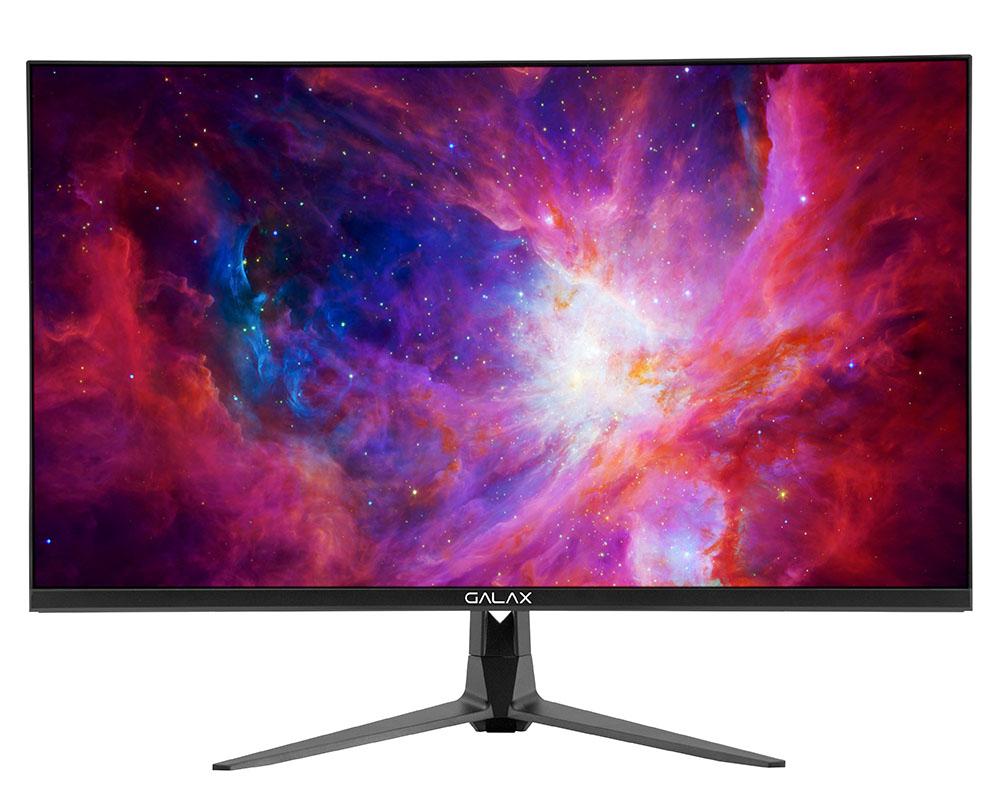
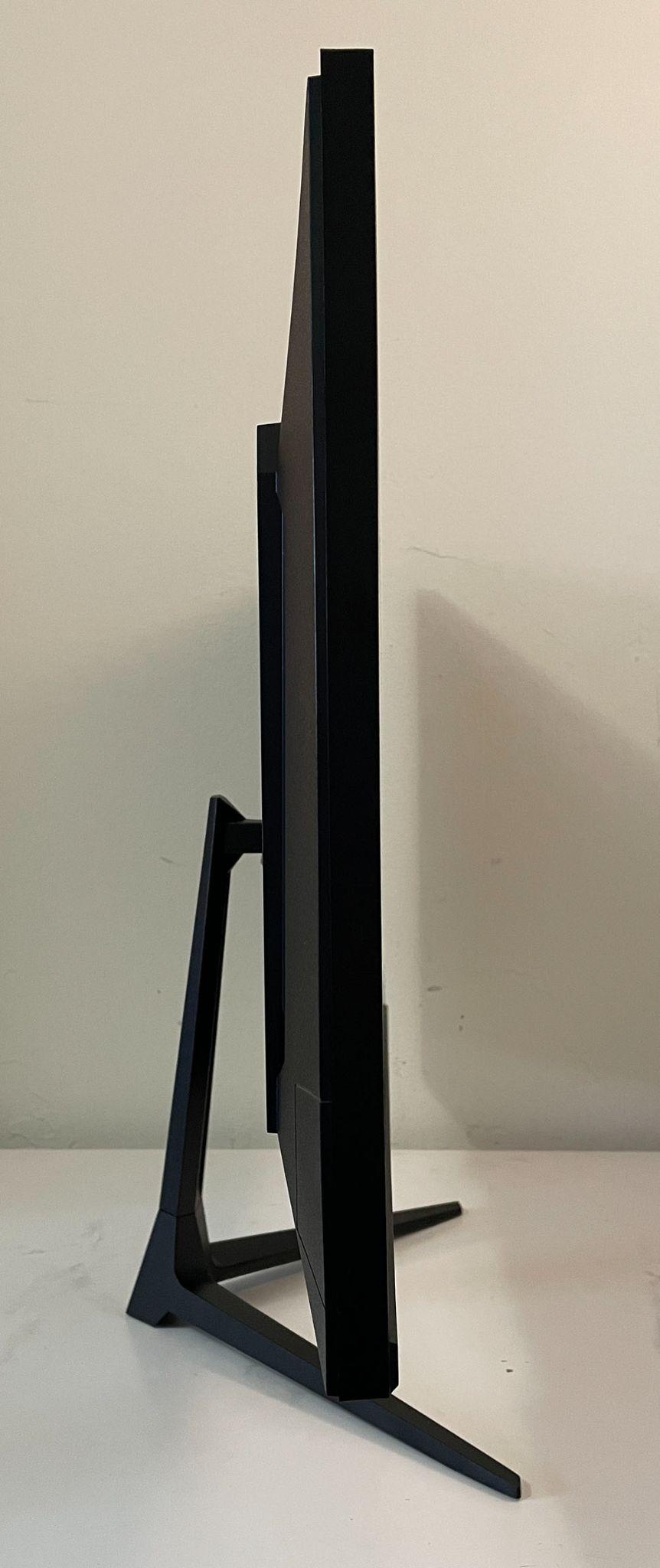
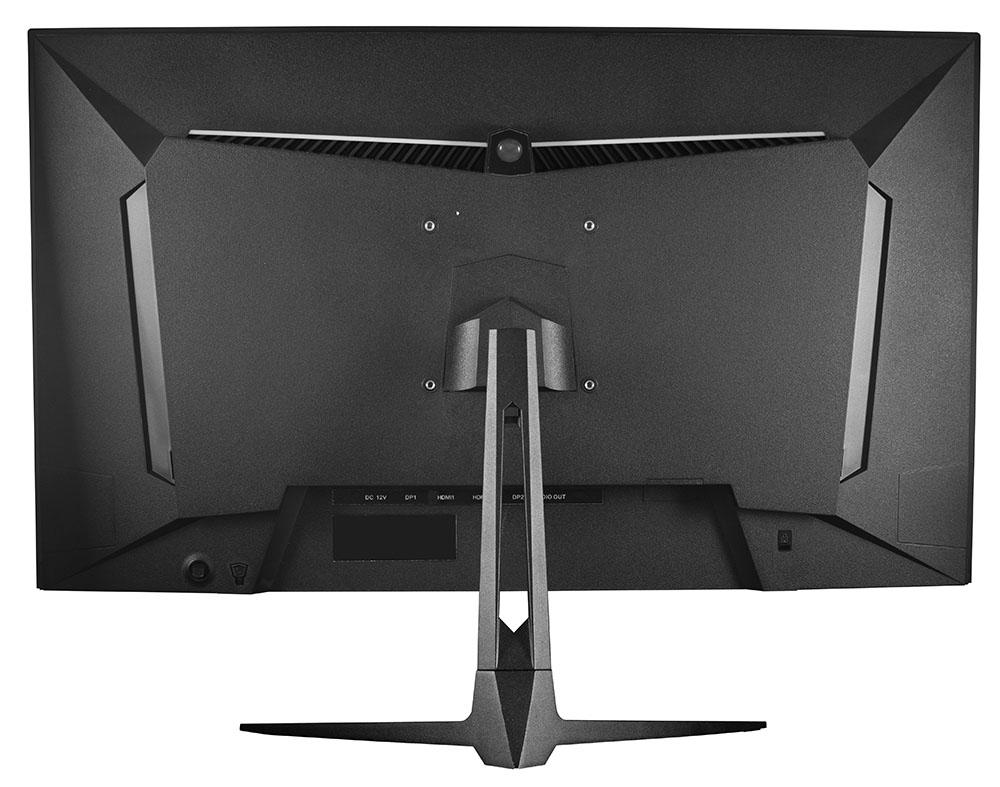
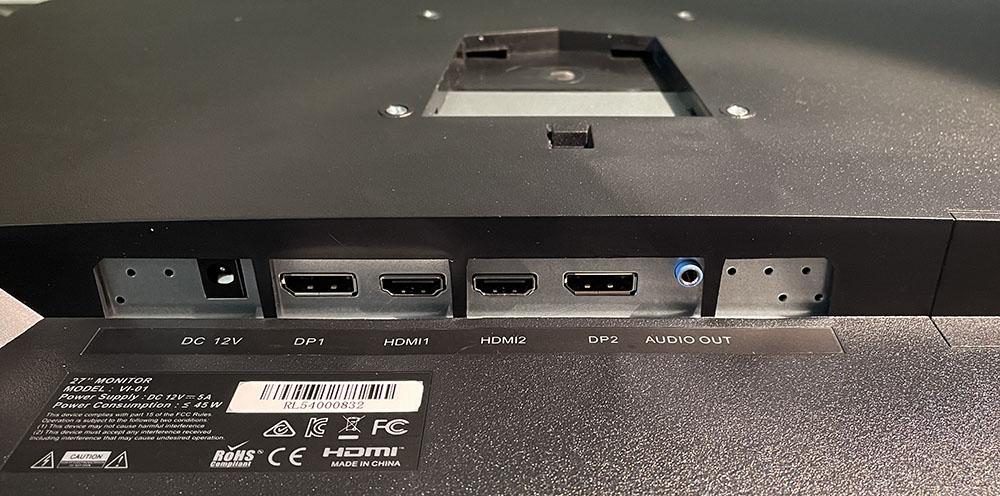

The VI-01’s styling is very simple, with a thin flush bezel in front surrounding a matte screen. The image is free of grain, and reflections are managed well. Only a small Galax logo appears on the bottom trim. The OSD joystick is in an unusual place, just right of center. There’s also a button to toggle G-Sync/Adaptive-Sync on and off. In the photo, you can see a small lens above the upright. That’s the LED feature that comes on the VI-01RGB model. My sample did not have this.
The stand is cast aluminum with a wrinkle finish that resists fingerprints and light in equal measure. The friction fit of the base and upright is something I haven’t seen before. It is very solid and does not pull apart easily. You can pick the VI-01 and move it around without fear of parts falling off.
Unfortunately, the rubber feet leave marks behind on your desk. I often slide monitors around my white table that serves as a testing area, and this one left faint black streaks on the surface. They cleaned up easily, but this is also something I haven’t seen before. The stand offers only -5/20 degrees of tilt, but there is no height adjustment, swivel or portrait mode. The screen sits a bit low for my average desktop, so I had to angle it upward to my eyepoint.
The clearly labeled input panel has two DisplayPort and two HDMI 2.0 inputs. You also get a 3.5mm audio output. The built-in speakers sound tinny like most monitors but are relatively free of distortion. There are no USB ports.
OSD Features of Galax Vivance VI-01
Though the VI-01 includes an OSD joystick, its function is not immediately intuitive. For instance, to move between the sub-menus, you’d think left and right would be the way to do it. Incorrect; it’s up and down. Left is cancel/return. And adjusting sliders is also up and down even though the sliders are horizontal. It’s a little wonky, but I got used to it after a short time. To activate the OSD, press the joystick and click right. Clicking down cycles through the six available aiming points, three shapes and two colors.
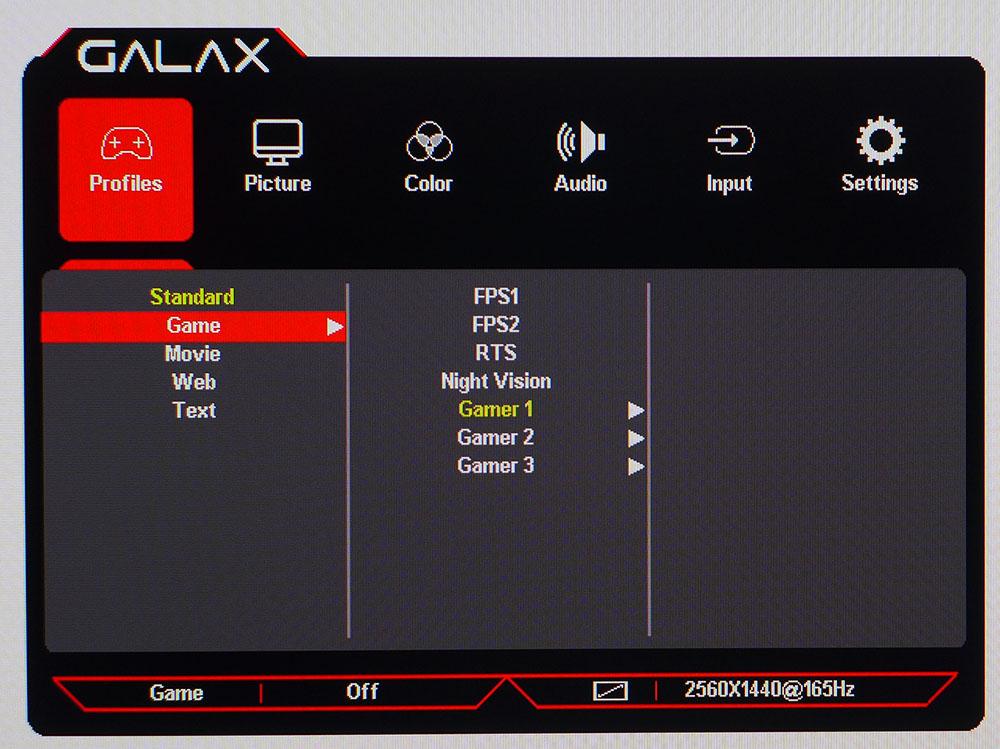
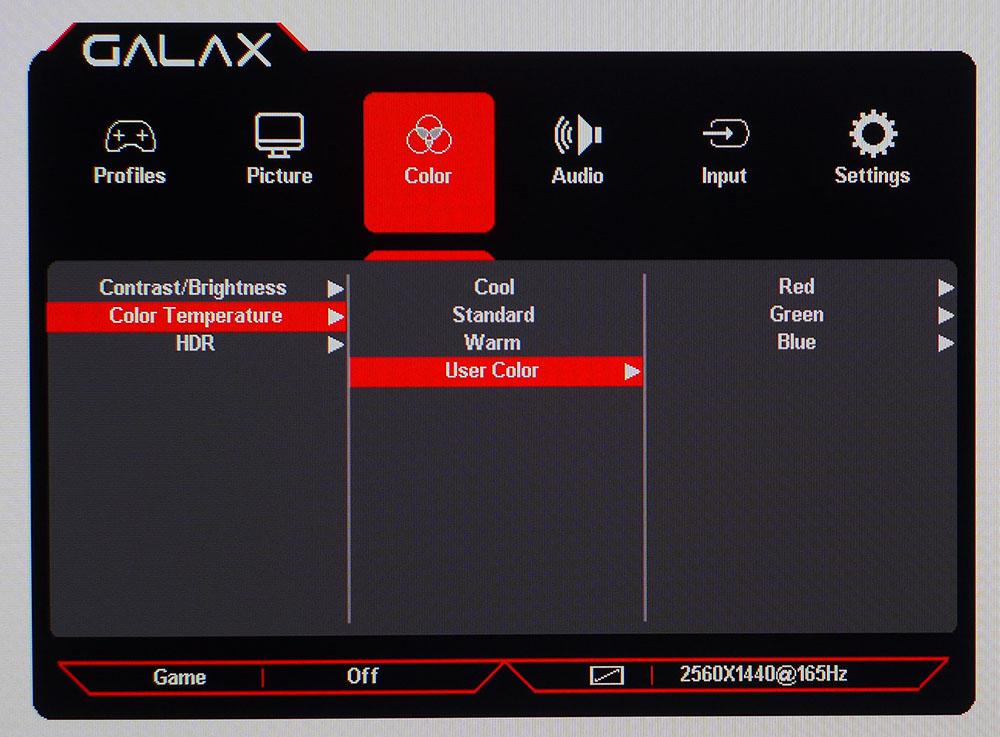
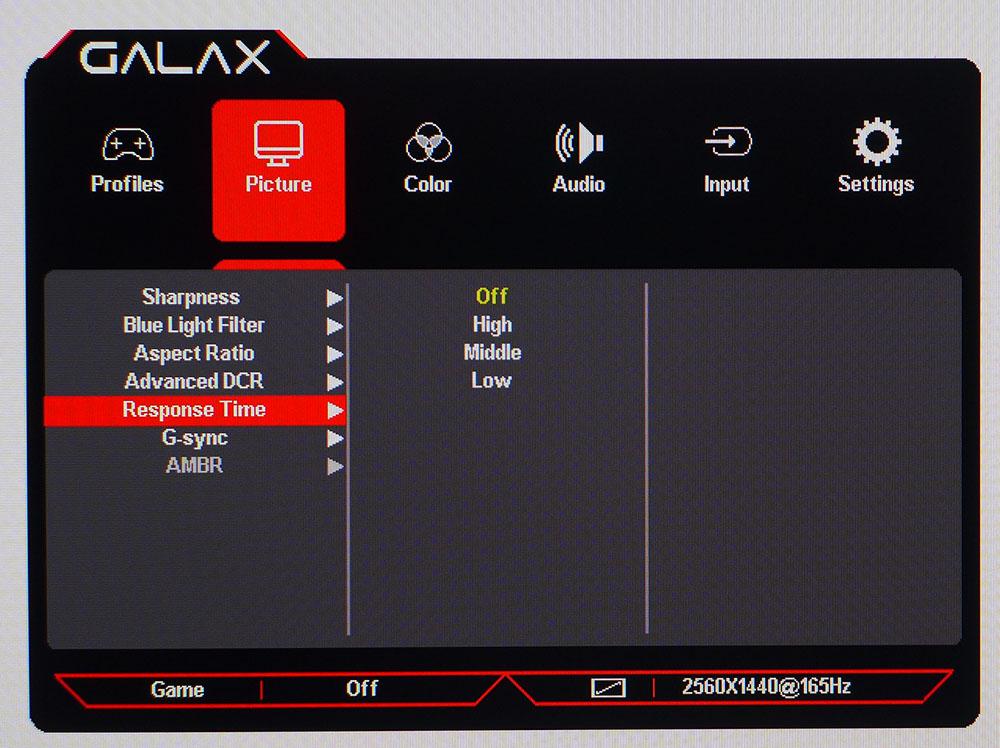
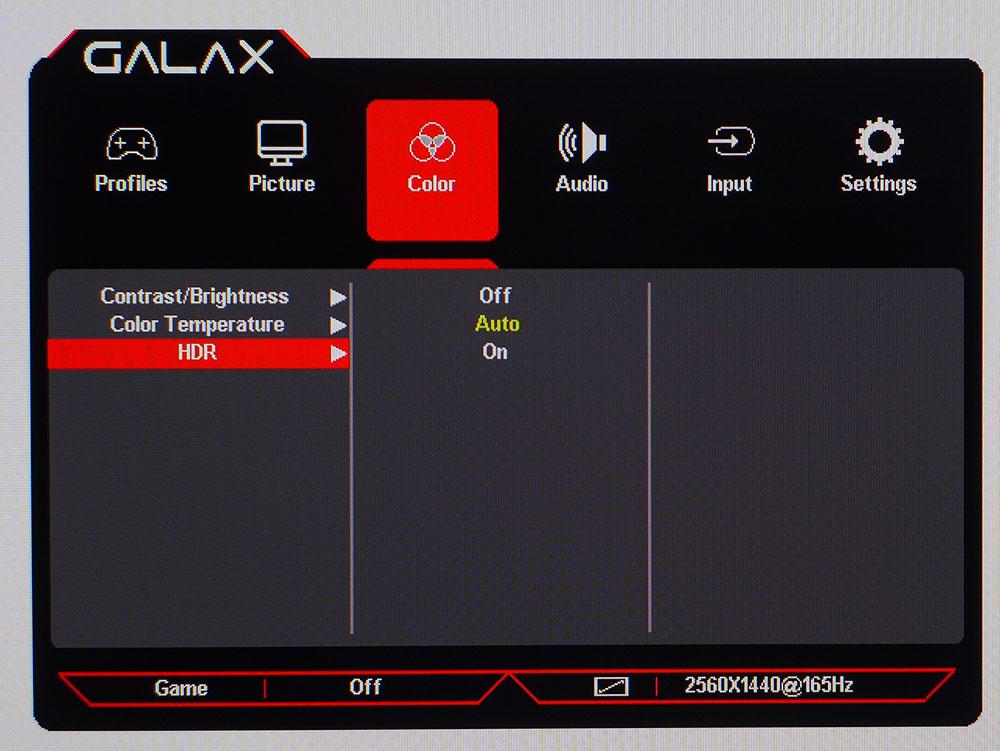
The VI-01 has five main picture modes with another seven under the Game label. The easiest way to avoid confusion is to stick with the default one, Standard. It offers enough image controls to correct the out-of-box color errors I found.
The Picture menu has video processing options, including G-Sync toggle, AMBR (backlight strobe) and Response Time (overdrive). I found the best motion processing with this turned off. The three settings all create ghosting artifacts that break up the edges of moving objects. The AMBR is a viable alternative to Adaptive-Sync. It only has a slight phasing artifact and maxes the brightness to prevent the dimming that usually occurs. And it is the smoothest motion available from the VI-01.
You can calibrate using the User Color with its RGB sliders. I achieved excellent grayscale tracking, but there are no gamma presets, which are sorely needed. The default curve is too light. HDR is set by default to Auto and switches automatically when HDR10 signals are present. However, there’s no additional contrast in this mode.
Calibration Settings for Galax Vivance VI-01
In the default Standard mode, the VI-01 has a cool grayscale, light gamma and under-saturated color. A grayscale calibration fixes one and three, but there are no gamma presets. This means the picture will be a bit lighter in overall tone with slightly less perceived contrast. My instrumented calibration settings shown below will make a visible improvement, especially in color saturation. I also noticed some edge enhancement at the default Sharpness setting. That slider should be set to zero for the clearest image.
When HDR is set to Auto, the VI-01 switches without user intervention when an HDR10 signal is applied. Color accuracy is good with a neutral grayscale and correct luminance tracking. I noted a few color saturation errors, which you can read about on page five.
| Picture Mode | Standard |
| Brightness 200 nits | 55 |
| Brightness 120 nits | 29 |
| Brightness 100 nits | 22 |
| Brightness 80 nits | 16 |
| Brightness 50 nits | Red 100, Green 97, Blue 93 |
| Contrast | 50 |
| Sharpness | 0 |
| Color Temp User | Red 100, Green 97, Blue 93 |
Gaming and Hands-on with Galax Vivance VI-01
I found the VI-01 looked a bit flat on the Windows desktop and when playing a few familiar games. It needs some tweaking to the grayscale and my visual observation suggested a light gamma. Tests and calibration confirmed that the gamma is indeed low, and grayscale runs cool by default. After calibration, the picture was much better with natural hues, greater color saturation and better-perceived contrast. Gamma still looked a little light, meaning the picture didn’t quite have the pop that comes with correct luminance tracking.
Moving on to work tasks, I found the VI-01 very competent for things like Word and Excel. Thanks to its sharp and detailed image, I could edit graphics without issue. I recommend setting Sharpness to zero to eliminate the slight edge enhancement I saw. It’s most visible when viewing black text against a gray background.
Gaming was a satisfying experience thanks to the VI-01’s smooth motion processing and low input lag. It is adequate for a gamer of my skills and will be a solid tool for nearly any player. G-Sync and FreeSync worked without issue, and I saw frame rates between 140 and 165 fps in both Doom Eternal and Call of Duty WWII. Overdrive was left off because any other setting created distracting ghosting artifacts, which broke up fine detail in moving objects and backgrounds.
The backlight strobe, called AMBR, also worked well with no visible artifacts in gameplay. When you turn this feature on, it locks the brightness on maximum, so there is no dimming of the image. It cancels out Adaptive-Sync as most monitors do, but I only saw the occasional frame tear. It is a viable option.
Image-wise, HDR looked a little better than SDR. Highlights were brighter, and I could see greater color saturation. To make a practical comparison, the VI-01 in HDR mode looks as good as a premium display running in SDR mode. It’s at its best when playing HDR content. SDR games like Tomb Raider have good color and detail but the low gamma veils the image slightly.
Overall, the VI-01 performs as expected for the price. It’s a good value and delivers excellent gaming performance but image quality, while good, has room for improvement.
MORE: Best Gaming Monitors
MORE: How We Test PC Monitors
MORE: How to Buy a PC Monitor: A 2022 Guide
MORE: How to Choose the Best HDR Monitor
Current page: Features and Specifications
Next Page Response, Input Lag, Viewing Angles and Uniformity
Christian Eberle is a Contributing Editor for Tom's Hardware US. He's a veteran reviewer of A/V equipment, specializing in monitors. Christian began his obsession with tech when he built his first PC in 1991, a 286 running DOS 3.0 at a blazing 12MHz. In 2006, he undertook training from the Imaging Science Foundation in video calibration and testing and thus started a passion for precise imaging that persists to this day. He is also a professional musician with a degree from the New England Conservatory as a classical bassoonist which he used to good effect as a performer with the West Point Army Band from 1987 to 2013. He enjoys watching movies and listening to high-end audio in his custom-built home theater and can be seen riding trails near his home on a race-ready ICE VTX recumbent trike. Christian enjoys the endless summer in Florida where he lives with his wife and Chihuahua and plays with orchestras around the state.
-
Sleepy_Hollowed ReplyKridian said:Amazon search for this monitor yields nothing. wtf?
The only country that they use Amazon with is India.
You can buy on the Galax store in USA and they have a list of where to buy in other countries.
To me that's an extra plus on why buy this monitor.
I don't know if you all know, but Amazon is a dumpster fire of fake listings and a place where companies get their products' information stolen by Amazon and then used for their own knock offs: https://www.reuters.com/legal/litigation/amazon-copied-products-rigged-search-results-promote-its-own-brands-documents-2021-10-13/
Any company that uses them outside of pure necessity due to being a monopoly is insane. -
Kridian Visited the Galax store (USA/galaxstore.net) and has no monitors on their page.Reply
Visited the overall Galax site (galax.com) and there is no option to buy.
There is a word I'm thinking here... fail, fail & fail some more. -
tylerwong2006 Monoprice and multiple brands on Amazon says that QHD 165Hz IPS isn't expensive to be goodReply